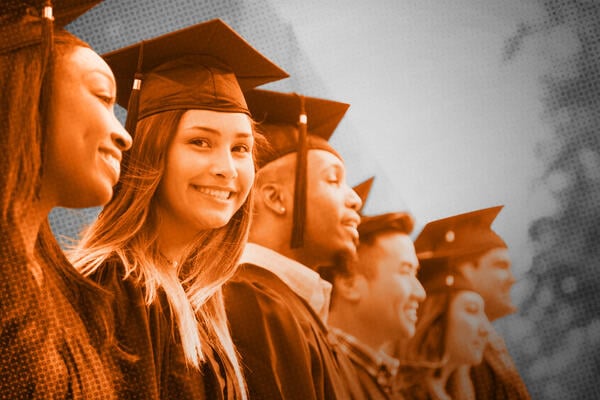
Survey: Undergraduates on Academic Quality
Eight in 10 students rate the quality of education they’re getting as good or excellent, according to the first round of results from Inside Higher Ed’s main annual Student Voice survey of more than 5,000 two- and four-year undergraduates with Generation Lab. That’s up from closer to seven in 10 students in last year’s main Student Voice survey, results that are affirming for higher education at a turbulent economic, technological and political moment.

Still, students point to room for improvement when it comes to their classroom experience—and flag outside issues that are impacting their academic success. Case in point: 42 percent of all students, and 50 percent of first-generation students, cite financial constraints as a top barrier to their success. This can include tuition but also living and other indirect expenses. Balancing outside work with coursework and mental health issues are other commonly cited challenges. Taken as a whole, the findings underscore the need for comprehensive wraparound supports and a focus on high-touch approaches in an ever more high-tech world.
About the Survey
Student Voice is an ongoing survey and reporting series that seeks to elevate the student perspective in institutional student success efforts and in broader conversations about college.
Look out for future reporting on the main annual survey of our 2025–26 Student cycle, Student Voice: Amplified. Future reports will cover cost of attendance, health and wellness, college involvement, career readiness, and the relationship of all those to students’ sense of success. And check out what students have already said about trust—including its relationship to affordability—and about how artificial intelligence is reshaping the college experience.
Some 5,065 students from 260 two- and four-year institutions, public and private nonprofit, responded to this main annual survey about student success, conducted in August. Explore the data from the academic life portion of the survey, captured by our survey partner Generation Lab, here. The margin of error is plus or minus 1 percentage point.
Here’s more on what respondents to our main annual Student Voice survey had to say about academic success.
- Students across institution types rate their educational experience highly.
Some 80 percent of students rate the quality of their college education thus far as good (50 percent) or excellent (30 percent), compared to last year’s 73 percent of students who rated it good (46 percent) or excellent (27 percent). This is relatively consistent across student characteristics and institution types—though, like last year, private nonprofit institutions have a slight edge over public ones, especially in terms of perceived excellence: In 2025, 47 percent of private nonprofit students rate their education excellent versus 27 percent of public institution students. This can’t be explained by two-year institutions being included in the public category, as community college students are slightly more likely than four-year students to describe their education as excellent (32 percent versus 29 percent, respectively). On community college excellence, one recent analysis by the Burning Glass Institute found that two-year institutions have dramatically improved their completion rates in recent years due in part to a concerted student success effort.
What about four-year college excellence? The Student Voice survey didn’t define quality specifically, but existing data (including prior Student Voice data) shows that students value connections with faculty. And with private nonprofit institutions having lower average faculty-to-student ratios than publics, one possible explanation is that students at private nonprofits may have extra opportunities to connect with their professors. But as other recent analyses demonstrate, private nonprofit institutions, even highly selective ones, do not have a monopoly on delivering life-changing educational experiences for students. Nearly 500 institutions—including community colleges, public universities, religious colleges and specialized colleges—this year achieved a new “opportunity” designation from the Carnegie Classification of Institutions of Higher Education, for example, signifying both high levels of access and strong economic outcomes for students.
2. Students want fewer high-stakes exams and more relevant course content, indicating this would boost their academic success.
Like last year’s survey, the top classroom-based action that students say would boost their academic success is faculty members limiting high-stakes exams, such as those counting for 40 percent or more of a course grade: 45 percent of students say this would help. Also like last year, the No. 2 action from a longer list of options is professors better connecting what they teach in class to issues outside of class and/or students’ career interests (40 percent). In Inside Higher Ed’s 2025 Survey of College and University Chief Academic Officers, just 20 percent of provosts said their institution has encouraged faulty members to limit high-stakes exams. But artificial intelligence is forcing a broader campus-assessment reckoning—and how to engage students and authentically assess their learning are questions central to those ongoing conversations. Relatedly, 10 percent of Student Voice respondents say promoting AI literacy would most boost their academic success.
3. Most students know how and when to use AI for coursework, but there are knowledge gaps between groups.
Upward of eight in 10 students indicate they know how, when and whether to use generative AI for help with coursework. In 2024’s survey, the plurality of students said this was because their professors had addressed the issue in class. This year, the plurality (41 percent) attributes this knowledge to professors including policies in their syllabi (up from 29 percent last year).
Like last year, relatively few students credit a college- or universitywide policy or other information or training from the broader institution. Across higher education, many institutions have held off on adopting broad AI use policies, instead deferring to faculty autonomy and expertise: Just 14 percent of provosts in Inside Higher Ed’s survey said their institution has adopted comprehensive AI governance policies and/or an AI strategy—though more said it has adopted specific policies for academic integrity, teaching and/or research (45 percent).
While classroom-based approaches are clearly evolving, two-year Student Voice respondents report being unclear on how, when and whether to use AI for coursework at double the rate of four-year peers (20 percent versus 10 percent). Perhaps relatedly, community college provosts were most likely to report significant faculty resistance to AI on their campuses, by institution type, at 49 percent versus 38 percent over all. Another difference: 23 percent of adult learners (25 and older) report being unclear, compared to just 10 percent of 18- to 24-year-olds. Both of these gaps merit further research.
4. Students say their institution’s course delivery methods and scheduling fit their needs—with some caveats.
Asked to what extent their institution offers course delivery methods/modalities that meet their learning needs and schedules, about four in 10 students each say very well or somewhat well. Adult learners (50 percent), community college students (49 percent) and students working 30 or more hours per week (45 percent) are especially likely to say their college is meeting their needs here very well—evidence that many nontraditional learners are finding the flexibility they need to balance college with busy lives.
However, students who say they’ve seriously considered stopping out of college at some point are especially unlikely to say their college is serving them very well here (33 percent). Risk factors for stopping out are varied and complex. But this may be one more reason for institutions to prioritize flexible course options. On the other hand, 48 percent of students who have stopped out for a semester or more but then re-enrolled say they’re being very well served by their current institution in this way.
5. Students’ biggest reported barriers to academic success aren’t academic.
From a long list of possible challenges, students are most likely to say that financial constraints (such as tuition and living expenses), needing to work while attending college, and mental health issues are impeding their academic success. None of these is explicitly academic, underscoring the need for holistic supports in student success efforts. Adult learners (51 percent), students working 30 hours or more per week (52 percent), first-generation students (50 percent) and students who have previously stopped out of college (55 percent) all report financial constraints at elevated rates. Racial differences emerge, as well: Black (46 percent) and Hispanic (49 percent) students are more likely to flag financial constraints as a barrier to academic success than their white (38 percent) and Asian American and Pacific Islander (37 percent) peers.
On mental health, women (37 percent) and nonbinary students (64 percent, n=209) flag this as a barrier at higher rates than men (26 percent). Same for students who have seriously considered stopping out of college relative to those who have not: 41 percent versus 30 percent, respectively.
Some of these issues are interconnected, as well: Other research has found a relationship between basic needs insecurity and mental health challenges that is pronounced among specific student populations, including first-generation and LGBTQIA+ students. Another recent study by the National College Attainment Network found that a majority of two- and four-year colleges cost more than the average student can pay, sometimes by as much as $8,000 a year. And prior Student Voice surveys have found that students link affordability to both their academic performance and to trust in higher education.
6. Colleges are meeting students’ expectations for responding to changing needs and circumstances—with some exceptions.
With so many different factors influencing students’ academic success, how are colleges doing when it comes to responding to students’ needs and changing circumstances, such as with deadline extensions, crisis support and work or family accommodations? Seven in 10 students say their college or university is meeting (57 percent) or exceeding (12 percent) their expectations. Most of the remainder say their institution is falling slightly short of expectations. This is relatively consistent across student groups and institution types—though students who have seriously considered stopping out of college are more likely than those who haven’t to say their institution is falling at least slightly short of their expectations (33 percent versus 19 percent, respectively). This again underscores the importance of comprehensive student support systems.
The Connection Factor
While it’s clear that AI and other outside variables are reshaping the academic experience, one mitigating influence may be human connection.
Jack Baretz, a senior studying math and data science at the University of North Dakota, is currently working with peers to develop an AI-powered tool called Kned that can answer students’ and advisers’ basic academic advising questions (think course sequencing, availability and prerequisites). The idea isn’t to replace advisers but rather counteract high adviser caseloads and turnover and—most importantly—maximize students’ time with their adviser so it’s a meaningful interaction.
“There’s a lot of anxiety kids have at this point in their life, where it’s like, ‘I don’t know what I’m going to do next. What would be a good major to make sure I get a job? I don’t want to be jobless.’ Just those conversations—I think that’s where advisers are most effective and probably most content, helping people,” Baretz said.

From left: University of North Dakota students and advising chatbot collaborators Michael Gross, Owen Reilly and Jack Baretz.
Zoom
A prior Student Voice survey found that nearly half of students lack key academic guidance. In this year’s survey, 19 percent of students say channeling more resources to academic advising so they can get more help from their adviser would most boost their academic success. Some 28 percent say the same of new and/or clearer program maps and pathways.
This ethos extends to what Kned collaborator Michael Gross, a junior majoring in finance, said keeps him academically engaged: connection. His most motivating online classes, for example, have had breakout rooms for peer-to-peer discussions. Why? “When you have more than one person working on something, you’re way more likely to contribute and do your best work on it, because there’s other people’s grades at stake, too,” he said. “It’s not just yours.”
Gross added, “One thing I would say is for institutions to encourage discussion on college campuses. The main thing that we’re kind of losing, especially with all this technology, is people are becoming so separated from each other. College is meant to be a place where you can engage your social skills and just learn about other people—because this is one of the last times you can be surrounded by so many people your age, and so many people from different walks of life with so many different ideas, too.”
To this point, 19 percent of Student Voice respondents cite social isolation or lack of belonging as a top barrier to their academic success. Tyton Partners’ 2025 “Time for Class” report also found a jump in both instructor and student preference for face-to-classes, “showing renewed demand for classroom connection.” In the same report, nearly half of instructors cited academic anxiety as a top concern among students, and students themselves reported low motivation and weak study habits as persistent barriers to learning.
Terry McGlynn, professor of biology at California State University, Dominguez Hills, and author The Chicago Guide to College Science Teaching, agreed that “learning is inherently a social endeavor.” And educators have for the past five years noticed “it’s a lot harder to get students to interact with one another and to show some vulnerability when experiencing intellectual growth.”
Many have attributed this to the effects of the pandemic, McGlynn said. But if higher education is now “heading into this era of AI in the classroom without reintegrating quality social interactions, I’m worried for us.”
He added, “I hope we develop approaches that bring people together rather than providing expectations that we work in isolation from one another.”
Source link



